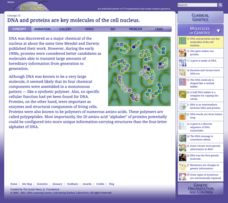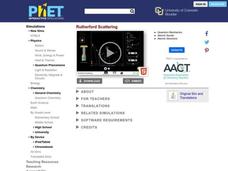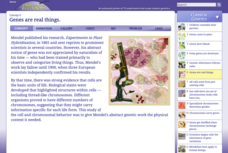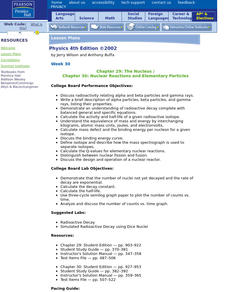Curated OER
Cell Organelles
Now, this is a clever approach to understanding cell organelles; seven pairs of organelles are listed, and pupils write an explanation of how each pair cooperates to perform certain cell functions. Organelles include the nucleus,...
Curated OER
What is the Nucleus Like?
In this nucleus of an atom worksheet, students answer 19 multiple choice questions about the structure of the atom, radioactive decay, isotopes and half life.
Cold Spring Harbor Laboratory
DNA and Proteins Are Key Molecules of the Cell Nucleus
When DNA research first began, it required almost an entire day to extract the molecules from a cell nucleus. Now it requires less than an hour. Scholars learn about the early theories of DNA with an online interactive, videos,...
Curated OER
The Nucleus-Radioactivity
In this nucleus and radioactivity worksheet, high schoolers collect class data and the students represent radioactive atoms decaying. They plot their data and answer two questions about the results. They solve seven problems given...
Curated OER
What's the Matter? Locating Electrons in an Atom
Young scholars roll dice in order to simulate the probability of locating an electron in a certain region around the nucleus.
Curated OER
The Spanish Omelet
Students use analogies to show the relationships among cell, nucleus, genes, chromosome, ribosome, replication, mitosis, transcription, translation, DNA, RNA, amino acids and proteins, genotype, phenotype, and genetics vs. environmental...
Curated OER
Difference One Proton Makes
Chemsitry aces learn that protons are located in the nucleus and the number of protons in the nucleus determines the atomic number of an element. In this instructional activity, they compare materials made up of a single element and...
Curated OER
Atomic Structure and Ionic Bonding (A Visual Approach)
Using toothpicks, marshmallows, and round colored sticky dots, physical science enthusiasts build models of an atomic nucleus. In this eighth grade chemistry lesson plan, they play an atom-naming game with the models that they have...
Curated OER
Cell Works
Young scholars observe slides of cork cells and discuss the use of microscopes. They view a power point presentation on "Looking Inside Cells" and take notes aligned with the PPT presentation. They collaborate with a partner to create an...
Curated OER
Human Cheek Cell
Get up close and personal with human cells with this lab worksheet. Learners use a microscope to examine their own cheek cells, drawing diagrams of the cells and identifying the parts when they have focused in on a visible specimen....
Curated OER
7.012 Fall 2004 Section Self-quiz
This quiz just looks neat! It has two cell diagrams for biology class members to label. They also describe the function of each organelle. A prokaryotic and eukaryotic cell are displayed for them to compare, and then they fill in the...
PhET
Rutherford Scattering
Rutherford performed his famous experiment in 1907 with Marsden, showing the true atomic structure. This interactive simulation compares Rutherford's historical experiment to the Plum pudding model of the atom. In both models, alpha...
Cold Spring Harbor Laboratory
Genes Are Real Things
Proving microscopic structures exist is a difficult task. Learn how scientists did just that in the mid-1800s as they set out to identify the cellular structures related to genetics. The online lesson explains the collection of work that...
Curated OER
Atomic Models
Your students should enjoy this slideshow which includes some basic definitions about the atomic structure of atoms. In fact, this presentation would be best-viewed before giving details and diagrams of neutrons, protons and quarks. The...
Curated OER
Atomic Theory, Structure, and Symbols
In this atomic theory worksheet, students review the observations that led to the conclusion of the atom having a positively charged nucleus. Students compare atomic number and mass number and explain how the discovery of subatomic...
Curated OER
Prokaryotic vs Eukaryotic
Students identify via slides prokaryotic and eukaryotic cells. They identify plant or animal cells from slides or pictures. Students are given the question of the day. They are asked which has a nucleus, a prokaryotic or eukaryotic...
Curated OER
Cell Campaign
Students work in groups to create a new head of the cell to take over for the nucleus. In this cell lesson students produce a campaign that will show the importance of the organelle to the cell.
Curated OER
Onion Cells
Students observe the cells of an onion by wet mounting it and viewing it in a microscope. In this hands on lesson plan students make their own wet mount slide of an onion and are able to identify the cells in it such as, the...
Curated OER
Countdown Challenge
In this countdown challenge worksheet, students find the 10 common elements from the human body, earth's crust, and ancient times and color code them. Students fill the atomic number of the elements in a given periodic table.
Curated OER
How do protons stick together in a nucleus?
Students explain that the Standard Model of the atom includes particles beyond protons, neutrons, and electrons. They describe the nucleus as conglomeration of quarks that manifest themselves as protons and neutrons.
American Chemical Society
The Periodic Table and Energy-Level Models
Teach your class to think of electrons as tiny packets of energy that travel in waves. Through a short video and diagram, participants see how electrons are located around the nucleus of an atom. They then get into groups and try to...
American Chemical Society
Protons, Neutrons, and Electrons
Atomic bombs harness the power in the nucleus of an atom, creating devastating power and damage. Classes review parts of an atom by charging a piece of plastic and holding it near their fingers, discussing what is happening and why....
Curated OER
The Nucleus / Nuclear Reactions and Elementary Particles
Students describe how radioactivity relates to alpha and beta particles. Using their properties, they write a descriptive paper about the gamma rays and alpha and beta particles. They calculate q-values and the half-life of a given...
Curated OER
Do Some Research
In this research instructional activity, students read the question, "A very small particle that revolves around the nucleus of an atom is called?" They use the library or Internet to find the answer, write the answer on the blue line,...























